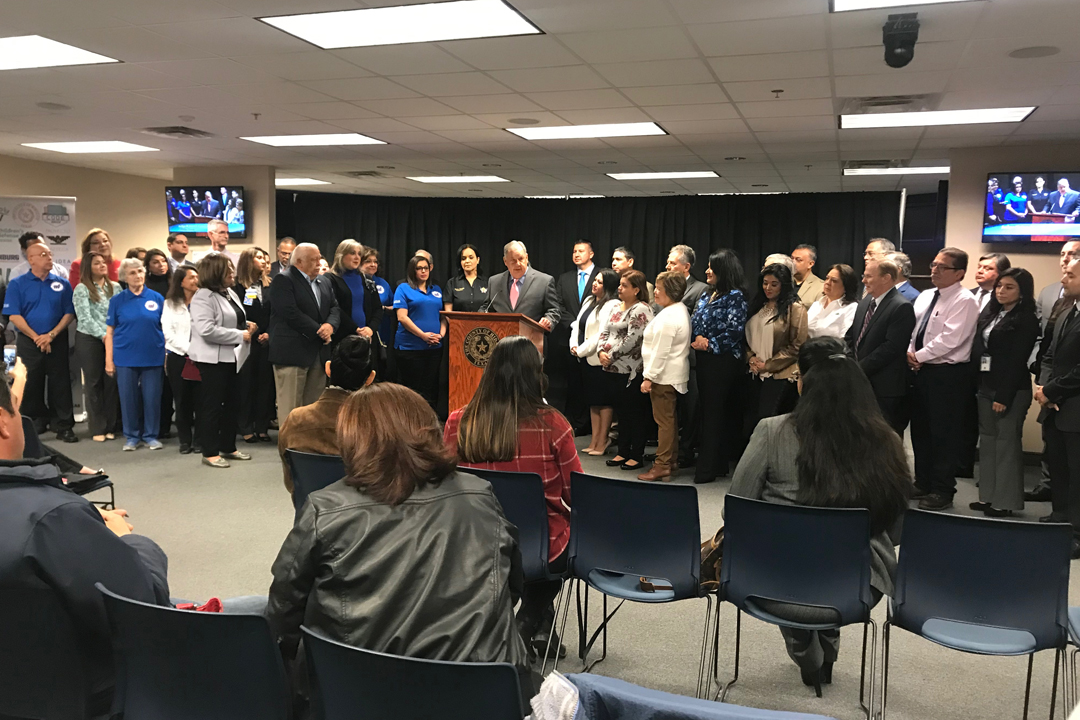“United We Count/Contamos Unidos ” campaign launched at news conference for 2020 Census
The “United We Count” campaign was met with support throughout the Rio Grande Valley this week.
This past Monday, elected officials, community leaders and regional stakeholders held two news conferences, one including leaders from Hidalgo County and Starr County, and another including leaders from Cameron County. The conferences were held as a public service announcement encouraging residents in the Rio Grande Valley to participate in the 2020 U.S. Census.
 During the morning conference, held at the Hidalgo County Commissioners Courtroom in Edinburg, officials and school leaders gathered to stress the importance of being counted in the census. Among those present were Hidalgo County Judge Richard Cortez, Starr County Judge Eloy Vera, Precinct 1 Commissioner David Fuentes, McAllen Mayor Jim Darling and Edinburg Mayor Richard Molina.
During the morning conference, held at the Hidalgo County Commissioners Courtroom in Edinburg, officials and school leaders gathered to stress the importance of being counted in the census. Among those present were Hidalgo County Judge Richard Cortez, Starr County Judge Eloy Vera, Precinct 1 Commissioner David Fuentes, McAllen Mayor Jim Darling and Edinburg Mayor Richard Molina.
“It’s going to take a very united effort for all of us to make sure that everybody in Hidalgo County is counted,” Fuentes said. “We have representatives from our schools, our cities, leadership and county representatives here. Hand in hand, we’re going to go out there and make sure that we get all the necessary counting done.”
Erika Reyna, the assistant chief of staff for Cortez, was one of many to speak on the lack of funding that has come as a result of low RGV census counts in the past.
According to the speakers, the RGV has been undercounted for many years because of the lack of participation in the U.S. Census.
“The ‘United We Count’ campaign, Contamos Unidos, is comprised of subcommittees, we’ve got business, media, community organization representatives, government officials and education partners represented here,” Reyna said.
Cortez mentioned that Hidalgo is the seventh largest county in Texas, and that statistics say that 35 percent of people living in the county live in poverty.
“So it’s extremely important that we maximize the funds that come to our area, from the federal government as well as our state government,” Cortez said. “We have an opportunity in this census to be counted.”
Cortez said that traditionally Hidalgo County has been undercounted in part because of undocumented residents fearing deportation, complacency and incorrect addresses.
“We think at least 20 percent of the people that live here may be undocumented workers, undocumented people,” Cortez said. “So when someone from the outside comes in and wants to count them, or wants to identify them and give them a census message, their concern was that a stranger was coming in [to their homes].”
The county also does not want to be complacent this year, and ensure everyone is counted without repercussion, according to Cortez.
“You can do it online, over the phone, and physically through mail,” Cortez said, adding that those physically collecting for the census should hopefully be familiar faces for residents.
Judge Vera said that the main issue with being undercounted is the lack of funding that results from it at the state and federal levels.
“We venture to say that we have closer to 50 percent in poverty [in Starr County],” Vera said. “So every dollar that we lose [in state and federal funding] is a tremendous loss for us.”
Speaking on how local education has been impacted by the census, Teresa Flores, the Executive Director of the Hidalgo County Head Start program, spoke on how local education has been impacted by the census, noting that Head Start is one of the more underfunded and underserved parts of the county. The goal of the program is to break the cycle of poverty and illiteracy in the Valley.
“The counts went down on the number of children under 5 years old by 4.5 percent. How is that? That’s not what we see in our communities,” Flores said. “Funding has been flat despite the fact that the number of children in our county have gone unserved. Approximately 16,000.”
“To me, when you have a 3 or 4-year-old child that doesn’t get into the classrooms, it’s very difficult for them to catch up later on,” Flores added, saying that the school districts in the area have come to the program’s rescue. “We do not get additional funds, yet we have additional mandates to be able to do what we do.”
Reyna said the county is excited to be partnered with several community establishments in order to raise more awareness that the 2020 Census is one year away.
“We want to continue to grow,” Reyna said. “We’ve got one year, we’re going to work very hard to make sure we provide the government with the information that is needed so we can make resources available and our community responds. United we count. Contamos unidos.”
The 2020 Census will be available to complete online starting March 23, 2020, and the official Census day is April 1, 2020.





